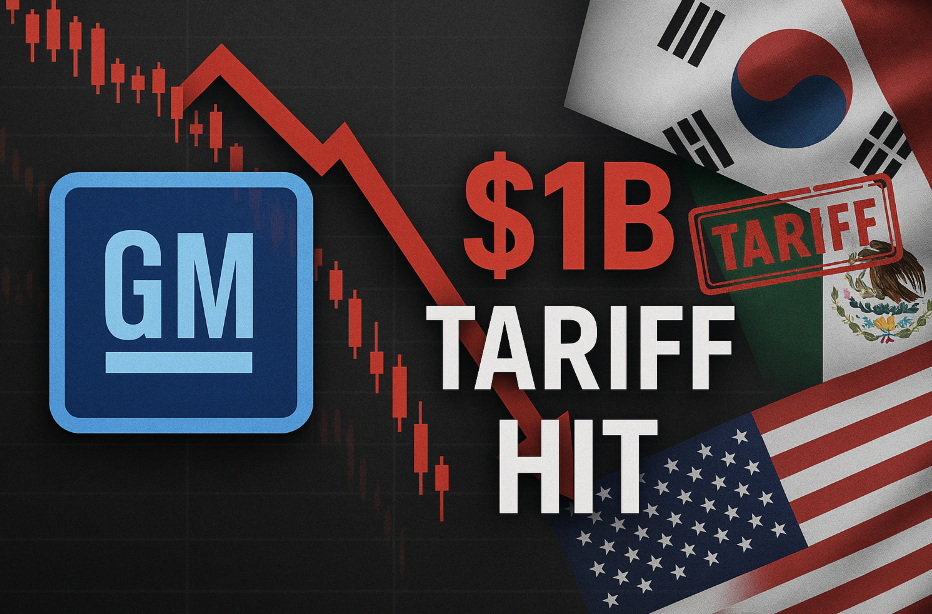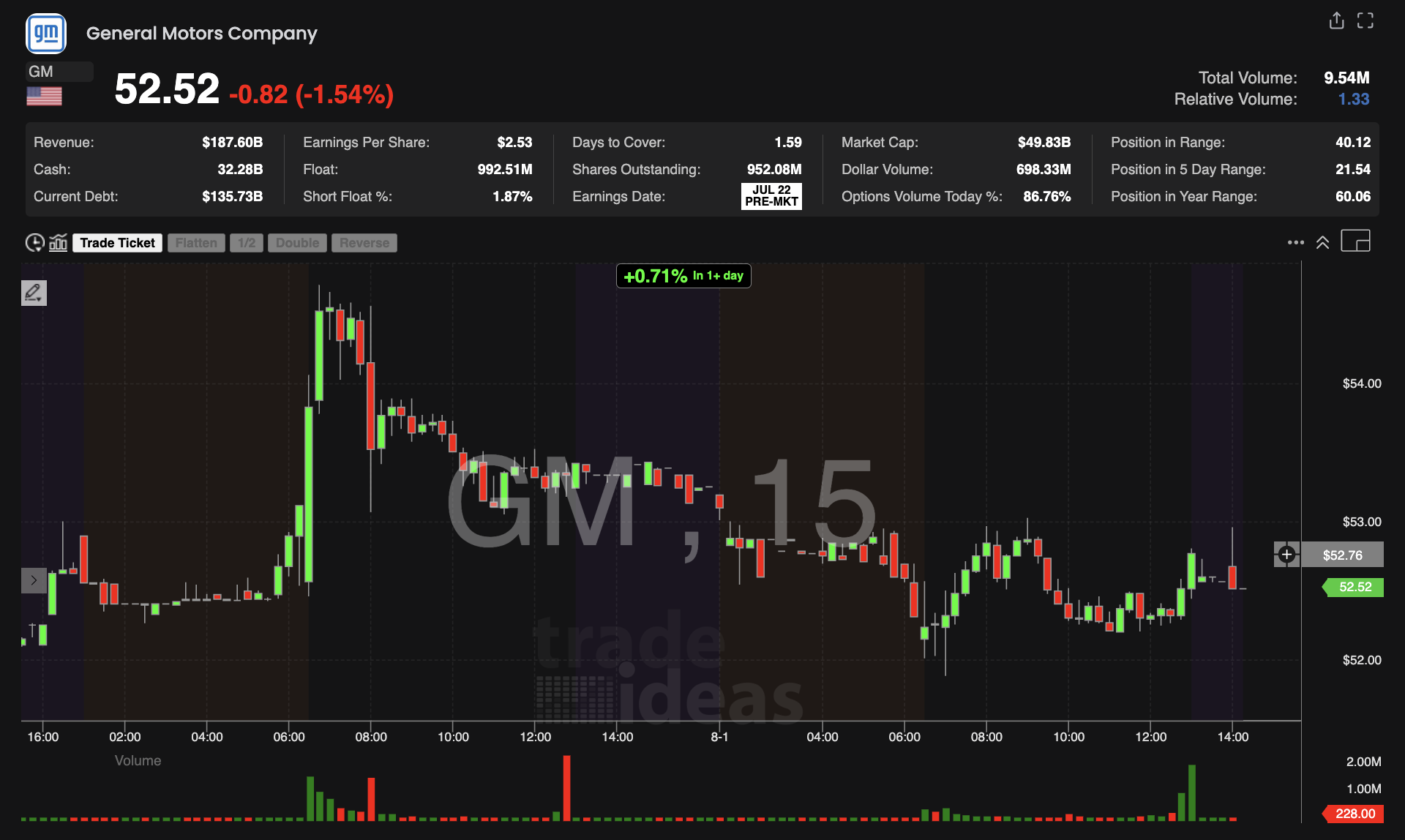GM’s $1B Tariff Hit: How Smart Traders Can Navigate Auto Sector Volatility
GM’s $1B Tariff Hit: How Smart Traders Can Navigate Auto Sector Volatility
The automotive sector just got a reality check that sent shockwaves through Wall Street. General Motors’ shares crashed 8% Tuesday after the company revealed that Trump’s tariffs slammed their second-quarter earnings with a devastating $1.1 billion hit – and warned that the pain is only getting worse, with up to $5 billion in annual impact expected.

This isn’t just bad news for GM; it’s a wake-up call for every trader watching the auto sector, signaling that policy-driven volatility is creating both significant risks and lucrative opportunities across the entire industry. While institutional investors scramble to reassess their positions, smart retail traders who understand how to navigate tariff-induced market swings are positioning themselves to profit from the chaos. The question isn’t whether more automotive earnings will disappoint – it’s how prepared you are to capitalize on the volatility when they do.
Understanding the Tariff Impact
The numbers tell the story of an industry under siege from trade policy shifts, with GM’s staggering $4-5 billion projected annual tariff burden serving as a stark reminder of how Trump’s aggressive trade stance is fundamentally reshaping automotive profitability. This massive financial hit isn’t just a GM problem – it’s a wake-up call about production vulnerability that highlights the critical difference between automakers who prioritize cheap overseas manufacturing versus those who maintain domestic operations. GM’s Achilles’ heel lies in its heavy reliance on imports, which account for roughly 50% of its US-sold vehicles, sourced primarily from Mexico and South Korea.
In contrast, Ford’s import ratio is more resilient, at 20%, reflecting years of strategic domestic investment. This production geography disparity explains why some automakers are getting crushed while others are merely bruised, creating clear winners and losers in the new tariff landscape. For traders, understanding each company’s production footprint isn’t just fundamental analysis – it’s survival, as the market rewards domestic manufacturing strategies while punishing global supply chain dependencies that seemed bright just months ago.
Immediate Market Reactions & Trading Signals
Tuesday’s market action delivered a masterclass in sector-wide contagion, with GM’s brutal 8% plunge dragging the entire auto sector into the red and forcing traders to ask the critical question: Is this an oversold bounce opportunity or the beginning of a much deeper correction? The ripple effects were immediate but varied – Ford dropped a modest 1, while Stellantis managed to stay flat. This suggests the market is already pricing in each company’s unique tariff exposure rather than painting the entire sector with the same broad brush.
Volume patterns tell an even more revealing story, with institutional selling accelerating into GM’s close, as retail traders create the classic setup for either a dead cat bounce or a genuine reversal. Key technical levels are now in play across the board: GM needs to hold its $42 support level to avoid a test of the $38 range, while Ford’s relative strength suggests it could outperform if the sector stabilizes around current levels.
Sector Rotation Opportunities
The tariff shock is accelerating a dramatic sector rotation that smart traders saw coming months ago – the shift away from overhyped EV growth stories back to the bread-and-butter profits of traditional gas-powered vehicle manufacturers. With EV tax credits disappearing and consumer demand cooling, companies that never abandoned their expertise in combustion engines are suddenly looking like strategic geniuses rather than dinosaurs. This rotation extends beyond just automakers to infrastructure and domestic production plays that are gaining serious momentum as reshoring becomes a competitive necessity rather than a political talking point.
The new tariff environment is creating clear winners and losers: domestic manufacturers with established US production facilities are emerging as safe havens, while companies heavily dependent on Mexican or Asian imports are being severely impacted, regardless of their environmental credentials. For traders, this represents a fundamental revaluation where old-school metrics like domestic production capacity and supply chain independence matter more than flashy electric vehicle delivery numbers, creating opportunities in overlooked traditional auto plays while punishing the high-flying EV stocks that dominated headlines for the past few years.
Strategic Trading Approaches
The current volatility in the automotive sector is creating multiple profit opportunities for traders willing to adapt their strategies to policy-driven markets. Short-term players should focus on volatility trading around earnings announcements, with options strategies being particularly effective for tariff-sensitive stocks that experience wild price swings. Meanwhile, pairs trading domestic manufacturers against import-heavy competitors offers a more hedged approach to capture the production geography premium. For longer-term position building, this selloff is creating genuine value opportunities in beaten-down auto stocks, especially those with strong domestic manufacturing footprints, infrastructure plays, and supply chain reshoring beneficiaries that will thrive as companies prioritize political stability over cost savings.
Success in policy-driven markets demands disciplined risk management that goes beyond traditional technical analysis. Position sizing becomes critical when political announcements can trigger 8% single-day moves – never risk more than 2-3% of your portfolio on any single tariff-sensitive play, regardless of how compelling the setup appears. Implement strict stop-losses at 15-20% below entry points to protect against sudden policy reversals, and diversify across sectors to avoid concentration risk in trade-sensitive industries. Most importantly, maintain higher cash reserves than usual during periods of elevated political risk, as the ability to move quickly on policy-driven opportunities.
What This Means for Retail Traders
This tariff-driven market chaos is actually a gift for savvy retail traders who understand their key advantage: speed and flexibility that institutional investors simply can’t match. While fund managers are constrained by massive positions that take weeks to unwind and compliance departments that slow down decision-making, individual traders can pivot instantly when policy news breaks, capturing the initial volatility that creates the biggest profit opportunities. The real goldmine lies in small-cap auto suppliers and manufacturers that institutions often overlook. Companies with domestic production facilities, reshoring capabilities, or specialized components for gas-powered vehicles are seeing their business models become extremely valuable overnight.
To identify these winners, focus on companies with manufacturing facilities in the US heartland, recent announcements about bringing production back home, or suppliers that benefit from the shift away from complex EV supply chains toward traditional automotive components. These smaller players often move 20-30% on tariff news, while receiving minimal analyst coverage, creating perfect conditions for retail traders who do their homework and move quickly on policy-driven opportunities.

Your Trading Game Plan for the New Auto Sector Reality
This new reality of policy-driven volatility demands more sophisticated tools and faster decision-making than traditional fundamental analysis can provide, which is where Trade Ideas becomes indispensable for navigating these treacherous waters. The platform’s real-time scanning capabilities can instantly identify tariff-sensitive stock movements as they happen, while AI-powered alerts help you catch sector rotation opportunities before the institutional money catches on.
Custom filters for domestic versus international production exposure enable you to quickly separate the winners from the losers in Trump’s trade war, and backtesting tools help refine strategies for policy-driven events that traditional technical analysis may not have anticipated. The bottom line is simple: in a market where political tweets can move stocks more than earnings reports, preparation and the right technological edge make the difference between profits and painful losses. Trade Ideas gives you the technological edge that separates profitable traders from those left scrambling after the headlines hit. In a market where preparation beats prediction every time, having the right tools isn’t just an advantage – it’s essential for turning market chaos into consistent profits.
Don’t let the next tariff announcement or earnings surprise catch you off guard – the traders who survive and thrive in this new environment are those who combine speed, technology, and disciplined risk management to turn policy chaos into consistent profits.
References
